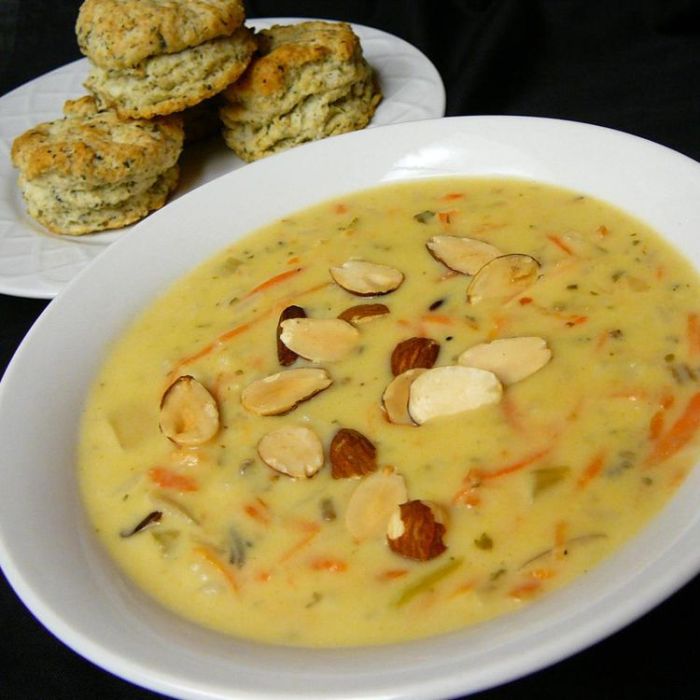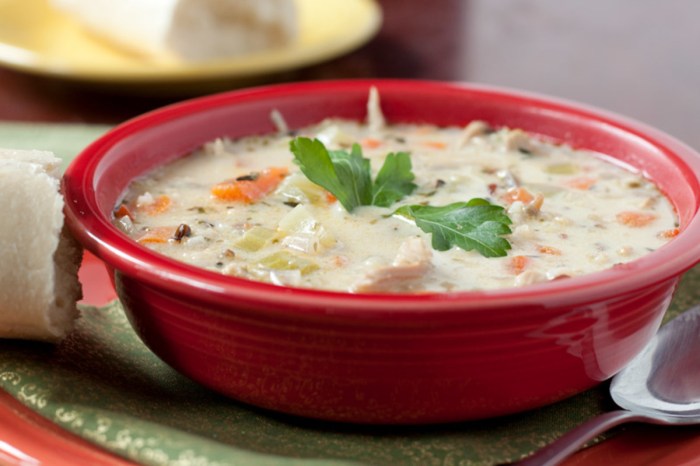Minnesota Wild Rice Soup: A Culinary Tradition
Wild rice soup recipe minnesota – Minnesota wild rice soup is more than just a dish; it’s a culinary reflection of the state’s rich history and natural bounty. Wild rice, or manoomin in Ojibwe, holds deep cultural significance for the Indigenous peoples of the region, who have harvested and cherished it for centuries. Its unique flavor profile, distinct from cultivated rice, has become a cornerstone of Minnesota cuisine, lending itself beautifully to hearty and comforting soups.
Introduction to Minnesota Wild Rice Soup

Source: thesweetsimplethings.com
Minnesota wild rice, unlike its cultivated counterpart, is an aquatic grass that grows naturally in shallow lakes and wetlands. This unique growing environment imparts a nutty, earthy flavor with subtle hints of sweetness, significantly different from the milder taste of long-grain or short-grain rice. The resulting soup is often described as savory and deeply flavorful, with a satisfying texture from the slightly chewy wild rice grains.
Essential Ingredients and Substitutions, Wild rice soup recipe minnesota
A classic Minnesota wild rice soup typically includes wild rice, broth (often chicken), vegetables like carrots, celery, and onions, and seasonings such as sage, thyme, and bay leaf. However, many variations exist to cater to different dietary needs and preferences.
For vegetarians, vegetable broth replaces chicken broth, and additional vegetables like mushrooms or squash can enhance the flavor and texture. Vegan versions can utilize vegetable broth and omit any meat or dairy products, potentially incorporating coconut milk for creaminess. Gluten-free options simply require ensuring all other ingredients are naturally gluten-free.
The choice of broth significantly impacts the soup’s flavor profile. Chicken broth lends a rich, savory depth, while vegetable broth provides a lighter, more vegetal taste. Beef broth adds a bolder, more robust flavor.
| Wild Rice Variety | Grain Size | Texture | Suitability for Soup |
|---|---|---|---|
| Minnesota Wild Rice | Medium to Long | Chewy, slightly firm | Excellent |
| California Wild Rice | Medium | Tender | Good |
| Canadian Wild Rice | Long | Chewy | Excellent |
| Black Wild Rice | Medium | Nutty, firm | Good (adds unique flavor) |
Recipe Variations and Techniques
Minnesota wild rice soup can be prepared on the stovetop for quicker cooking or in a slow cooker for a more hands-off approach. The slow cooker method often results in a more deeply flavored soup due to the longer cooking time.
Many enjoy a hearty bowl of wild rice soup, a Minnesota classic. The creamy texture contrasts beautifully with the nutty wild rice; for a different kind of creamy soup, you might explore a tomato soup recipe crushed tomatoes , which offers a vibrant, acidic counterpoint. Returning to the wild rice soup, remember to toast the rice for enhanced flavor before adding your broth and vegetables.
Creamy versions are achieved by incorporating cream, milk, or coconut milk towards the end of cooking. Broth-based versions maintain a lighter consistency. A Minnesota autumn variation might include butternut squash, parsnips, and cranberries, reflecting the seasonal harvest.
Traditional recipes often emphasize simplicity and the natural flavors of the wild rice and vegetables. Modern interpretations may incorporate more complex spice blends or unusual vegetable combinations, resulting in a wider range of flavor profiles.
Serving Suggestions and Accompaniments
Minnesota wild rice soup pairs well with various accompaniments, enhancing the overall dining experience. The warmth and heartiness of the soup make it a perfect complement to crusty bread for dipping, a light salad for contrast, or a comforting grilled cheese sandwich.
- Crusty bread
- Mixed green salad with a light vinaigrette
- Grilled cheese sandwich
- Fresh herbs (parsley, chives)
- Roasted pumpkin seeds
- Crispy fried onions
For a special occasion, consider serving the soup in elegant bowls, garnished thoughtfully. Serving temperature influences the soup’s texture and flavor; a warm, but not overly hot, temperature allows the flavors to fully develop without being scalding.
Nutritional Information and Health Benefits

Source: allrecipes.com
Wild rice is a nutritional powerhouse, rich in fiber, manganese, magnesium, and antioxidants. A typical serving of wild rice soup provides a good source of these nutrients, along with the vitamins and minerals from the vegetables included in the recipe. A healthier version can be made by using low-sodium broth, lean meats (if included), and reducing the amount of added fats.
Visual Representation of the Recipe

Source: saymedia-content.com
The finished soup is typically a rich, earthy brown color, with the texture varying depending on the recipe. A creamy version will have a smoother consistency, while a broth-based version will be more fluid. The wild rice grains are visible throughout, providing textural contrast. Garnishes such as fresh herbs add pops of green, while roasted vegetables introduce vibrant colors and textures.
During the cooking process, the vegetables will soften and deepen in color, while the wild rice will absorb the broth and become plump and tender. The overall visual transformation from raw ingredients to the finished soup is a testament to the cooking process.
FAQ Guide: Wild Rice Soup Recipe Minnesota
Can I freeze wild rice soup?
Yes, wild rice soup freezes well. Allow it to cool completely before storing in airtight containers for up to 3 months.
What is the best type of wild rice to use?
While many varieties work, long-grain wild rice is generally preferred for its texture and ability to hold its shape in soup.
How can I make this soup spicier?
Add a pinch of red pepper flakes or a dash of your favorite hot sauce to adjust the spice level to your liking.
Can I use leftover cooked wild rice?
Yes, you can use leftover cooked wild rice to reduce cooking time. Just add it during the last 15 minutes of cooking.
